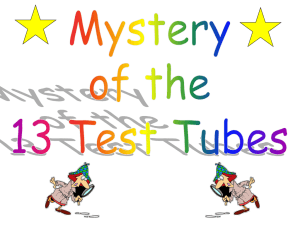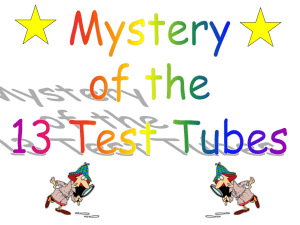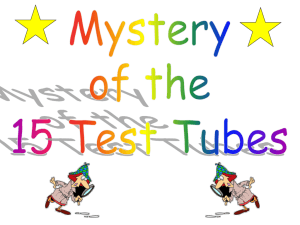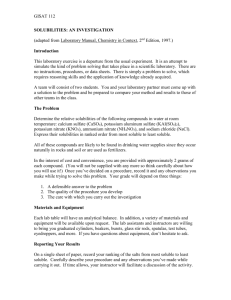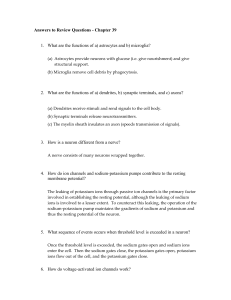Document
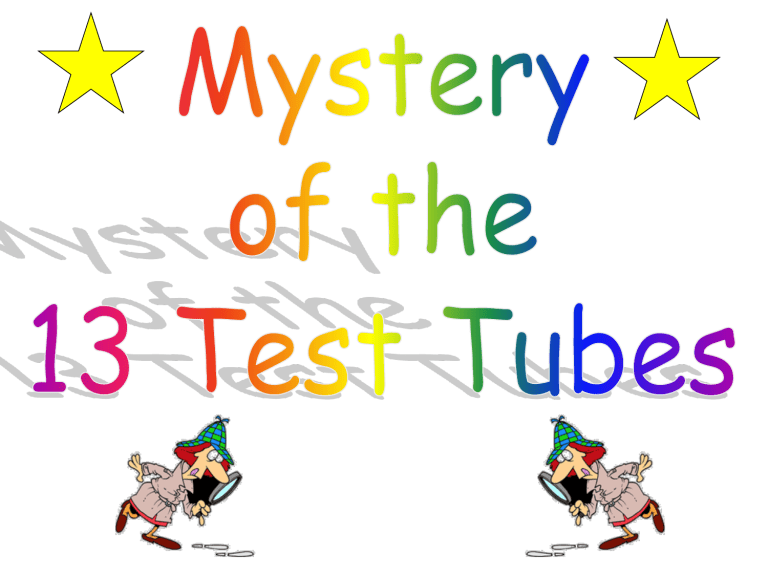
Objective
To identify the contents of thirteen different test tubes using a few simple tests and their mutual reactivities.
Simple Tests
Color – Transition metals tend to form brightly colored compounds.
Odor – Some compounds have very distinctive odors.
When testing for odor always remember to WAFT!
pH – Using universal litmus paper determine the pH of the compound.
Solubility – By combining the unknowns and knowing the rules of solubility, one can determine the contents of the test tubes.
Flame Test – Metal ions when introduced into a flame give a distinct emission spectrum. The color of the flame can help identify the unknown metal.
Definitions Applicable to Ionic Reactions
Ions – Charged Species.
Metals tend to form cations and Nonmetals tend to form anions.
Ionic substances tend to dissolve readily in water to form solutions because they are charged particles that should electrostatically attract the corresponding end of the water dipole.
However, not all ionic substances are soluble in water , indicating that they do not have enough energy to break apart the ionic crystal.
Cations – Positively charged ions.
Cations in today’s experiment include: H + , Na + , K + , Ca 2+ , Ba 2+ ,
Fe 3+ , Cu 2+ , Ni 2+ , and Sn 2+ .
Anions – Negatively charged ions.
Anions in today’s experiment include: Cl , S 2, NO
CrO
4
2, and C
2
0
4
2.
3
, SCN , SO
4
2,
Soluble The term soluble means that a substance dissolves.
An aqueous solution is soluble. If one mixes two solutions together and no precipitate forms , then only the ions are in solution. Thus, there is no reaction.
Note: Sometimes two solutions are mixed together, a reaction can occur that does not form a precipitate . Usually when this type of reaction takes place, there is a marked color change when the product is formed or a large temperature change is observed.
Insoluble The term insoluble means a substance does not dissolve .
Precipitate – A solid beneath a liquid.
If one mixes two solutions and a solid forms, this is called a precipitation reaction .
Solubility Rules
1. All nitrates, chlorates, and acetates of all metals are soluble.
Silver acetate is sparingly soluble.
2. All sodium, potassium, and ammonium salts are soluble.
3. All chlorides, bromides, and iodides are soluble except silver, lead (II), and mercury (I).
4. All sulfates are soluble except barium, calcium, strontium, lead (II), and mercury (I).
5. Carbonates, phosphates, borates, sulfites, chromates, and arsenates of sodium, potassium, and ammonium are soluble; all others are insoluble.
6. Sulfides of barium, calcium, magnesium, sodium, potassium, and ammonium are soluble ; all others are insoluble.
7. Hydroxides of sodium, potassium, and ammonium are soluble.
Hydroxides of barium and calcium are moderately soluble.
8. Everything else will be considered insoluble!
Ionic Equations & Precipitation Reactions
Overall Equation – Shows reactants and products as undissociated, electrically neutral compounds.
AgNO
3(aq)
+ NaCl
(aq)
NaNO
3(aq)
+ AgCl
(s)
Complete Ionic Equation – Shows the state of reactants and products as hydrated or other phases.
Ag +1
(aq)
+ NO
3
-1
(aq)
+ Na +1
(aq)
+ Cl -1
(aq)
Na +1
(aq)
+ NO
3
-1
(aq)
+ AgCl
(s)
Net Ionic Equation – Shows only the reactants and products that are directly involved in the reaction.
Ag +1
(aq)
+ Cl -1
(aq)
AgCl
(s)
Spectator Ions – Ions which are not directly involved in the net ionic equation are called spectator ions. In the previous equation, this would be the sodium and nitrate ions.
Ag +1
(aq)
+ NO
3
-1
(aq)
+ Na +1
(aq)
+ Cl -1
(aq)
Na +1
(aq)
+ NO
3
-1
(aq)
+ AgCl
(s)
Ag +1
(aq)
+ NO
3
-1
(aq)
+ Na +1
(aq)
+ Cl -1
(aq)
Na +1
(aq)
+ NO
3
-1
(aq)
+ AgCl
(s)
(Spectator Ions)
Ag +1
(aq)
+ Cl -1
(aq)
AgCl
(s)
(Net Ionic Equation)
Flame Tests
The flame test is a procedure used in chemistry to detect the presence of certain metal ions , based on each element's characteristic emission spectrum . The color of flames in general also depends on temperature.
The flame test is fast and easy to perform , and does not require any equipment not usually found in a chemistry laboratory. However, the range of detected elements is small , and the test relies on the subjective experience of the experimenter rather than any objective measurements.
Flame Tests
The test involves introducing a sample of the element or compound to a hot, non-luminous
(blue) bunsen flame , and observing the color that results.
Flame Test Calcium
Samples are usually held on a nichrome wire cleaned with hydrochloric acid to remove traces of previous analytes.
Glass Rod with Nichrome Wire
Flame Tests
Potassium - Purple Sodium - Yellow
Barium - Green
Sodium is a common component or contaminant in many compounds and its spectrum tends to dominate over others. Thus the color yellow overpowers the true color .
The test flame is often viewed through cobalt blue glass to filter out the yellow of sodium and allow for easier viewing of other metal ions.
As Arsenic - Blue
B Boron - Bright Green
Flame Tests
Mg Magnesium - Brilliant white
Mn(II) Manganese(II) –
*Ba Barium - Apple Green
Yellowish green
Mo Molybdenum - Yellowish green
Ca Calcium - Brick Red
Cs Cesium - Pale Violet
*Na Sodium - Intense Yellow
Cu(I) Copper(I) - Blue
P Phosphorus - Pale bluish green
Cu(II) Copper(II) (non-halide) -
Pb Lead - Pale green
Green
Rb Rubidium - Pale violet
*Cu(II) Copper(II) (halide) -
Sb Antimony - Pale green
Se Selenium - Azure blue
Blue-Green
Sr Strontium - Crimson Red
*Fe Iron - Gold
Te Tellurium - Pale green
In Indium - Blue
Tl Thallium - Pure green
*K Potassium - Lilac
Zn Zinc - Bluish Green
Li Lithium – Carmine Red
And Now for the
Main Event!
Mystery of the Thirteen Test Tubes
It was a cold dark night and one of the TAs was preparing the solutions for this week’s experiment.
The TA had made a key for the unknowns and placed the key on the lab bench in the stockroom before she went home for dinner.
While the TA was out, one of the stockroom workers decided to help clean the stockroom.
(They know how upset Dr. Bone gets when the stockroom is a mess!) And – you know it – the stockroom worker threw away the key!
Yeah, we know it’s cheesy
!
So now it is up to you to identify the contents of the 13 Test Tubes.
The Usual Suspects
1.H
2
SO
4
2.K
2
CrO
4
3.Fe(NO
3
)
3
4.Na
2
S
5.NiSO
4
6.KNO
3
7.Ba(NO
3
)
2
8.NH
3
9.NaCl
10.K
2
C
2
O
11.Cu(NO
4
3
)
2
12.SnCl
2
13.KSCN
H
2
SO
4
Bio: Strong Acid, most powerful industrial chemical in the world, may produce insoluble sulfates if “metal”ed
(meddled) with .*
*Recall #4 of our solubility rules:
All sulfates are soluble except barium , calcium, strontium, lead (II), and mercury (I).
Sulfuric Acid
MSDS for H
2
SO
4
Corrosive; highly exothermic reaction with water. Burns from sulfuric acid are potentially more serious than those of comparable strong acids (e.g. hydrochloric acid), as there is additional tissue damage due to dehydration and particularly due to the heat liberated by the reaction with water; i.e. secondary thermal damage.
The danger is greater with more concentrated preparations of sulfuric acid; however, even the "dilute" ~ 0.1 M H
2
SO
4 will char paper by dehydration if left in contact for a sufficient while.
Ammonia NH
3
Bio: Alias Ammonium Hydroxide (NH
4
OH) has done important work in homes, last known employment as fertilizer, can turn ugly on any nosey detectives.
A gas with a characteristic pungent odor. Caustic and can cause serious health damage. Exposure to very high concentrations of gaseous ammonia can result in lung damage and death.
K
2
CrO
4
Bio: Best known for its bright disposition , potassium ion is almost inert, but the chromate may drop out if faced with silver, lead or barium . Remains bright even when it lays low.
Potassium Chromate
K
2
CrO
4
Potassium Chromate is very toxic and may be fatal if swallowed. It may also act as a carcinogen , and can create reproductive defects if inhaled or swallowed.
It is a strong oxidizing agent .
It may react rapidly, or violently.
It is also possible that it may react explosively with other reducing agents and flammable objects.
NaCl
Bio: Nothing but a common salt, almost impossible to recognize in a crowd, but shows quite a yellow streak when the real heat is on.*
Sodium Chloride
*i.e., the flame test will yield a yellow flame.
Ferric
Fe 3+
Fe(NO
3
)
3
Ferrous
Fe 2+
Bio: Alias “ Iron III ” – Ferric is more reactive than younger brother Ferrous; may be recognized by color if not confused with other species, can be definitively identified by “ Bloody ” encounter with greatest rival
Thiocyanate .*
Ferric Nitrate
(*More about that in the KSCN slide.)
K
2
C
2
O
4
Potassium Oxalate
Bio: Actions not well known, but moderate toxicity noted, handle with care, believed to have a falling out with “Barium”.
Sodium Sulfide
Na
2
S
Bio: Alias “ Le Pew ”, a real loner, possible messy confrontations with copper, ferric, nickel or tin ; tends to linger on the skin if touched.
(Do NOT Touch!)
Caution: Na
2
S + H
2
SO
4 yields which smelly gas?
Cu(NO
Bio: First name officially changed to “ Copper II ”; leading chemical citizen, many business ventures include electrical wire manufacturing and production of alloys, notably brass; in solution is easily recognizable by “ melancholy ”
(sad or blue) disposition.
3
)
2
Cupric Nitrate
Note: Once suspected of conspiring with ammonia to impersonate blue ink.
NiSO
4
Bio: Once very valuable, now net worth greatly reduced, “ Nick ” is easily recognized by his “ envious ”
(green) nature.
Nickel Sulfate
Caution: Nickel salts are considered carcinogenic.
SnCl
2
Bio: a.k.a. Tin Chloride, a hard worker, known since ancient times, currently employed in food packaging industry, recyclable; fluoride form prevents tooth decay; somewhat acidic personality; unfortunate confrontation with “Le Pew”.
Note: Stannous Chloride was prepared in 1 M HCl, so it will appear quite acidic.
Stannous Chloride
Unfortunate Confrontation with “Le Pew”
Solutions of tin ( II) chloride can also serve simply as a source of Sn 2+ ions, which can form other tin (II) compounds via precipitation reactions, for example brown (or black) tin (II) sulfide:
SnCl
2
(aq) + Na
2
S(aq) → SnS(s) + 2 NaCl(aq) stannous sulfide (′stan· ə s ′s ə l′f ī d) SnS Dark crystals; insoluble in water, soluble (with decomposition) in concentrated hydrochloric acid; melts at 880°C; used as an analytical reagent and catalyst, and in bearing material.
Also known as tin monosulfide; tin protosulfide; tin sulfide.
KNO
3
Bio: The “ Most Boring ” substance known outside of the noble gasses, chronically unemployed, does not participate in chemical reactions but often “ watches ”.
Potassium Nitrate
Can be distinguished from the other “ common salt ” by its pale violet response to any “ trial by fire .”
KNO
3 (aq)
KNO
3 (s)
While potassium nitrate may be boring in solution, the solid is a critical oxidizing component of black powder gunpowder . In the past it was also used for burning fuse technologies including slow matches.
It readily precipitates and was widely "harvested" since the Late
Middle Ages and Early Modern era through the 19th century from urine from which it was forced to crystallize in various odorous ways. Its common names include saltpeter , American English saltpeter, & Nitrate of potash.
KSCN
Bio: Poisonous little creature, approach with caution, longstanding “ blood ” feud with the Iron Brothers.
Potassium Thiocyanate
Chemists are always trying to make mimics of the Chemicals found in nature. We can do this by mixing
Iron(III) compounds with potassium
Thiocyanate . The Chemical we get is similar to the Iron-containing part of hemoglobin and is a blood red color .*
*Note: It may appear black in the well, use a toothpick to smear some on a piece of filter paper to verify color.
KSCN + FeCl
3
Ba(NO
3
)
2
Bio: Little known on this one, chance encounters with sulfuric acid have often
“precipitated ” pale consequences.
Barium Nitrate
Toxic by ingestion or inhalation. Symptoms of poisoning include tightness of muscles (especially in the face and neck), vomiting, diarrhea, abdominal pain, muscular tremors, anxiety, weakness, labored breathing, cardiac irregularity, and convulsions. Death may result from cardiac or respiratory failure, and usually occurs a few hours to a few days following exposure to the compound. Barium nitrate may also cause kidney damage.
The NITRATES are a red herring.
Lead in the
Wrong Direction
For March 3-6
Read: Radiochemistry You will need the Green Book for this experiment. (It may be purchased for $10.00
cash or check in Room 142 Schrenk .)
Due: 13 Test Tubes (pp 109-114)* - You may turn in the lab either the week of Feb. 23-26 or Mar. 3-6 .
*This material will be on the midterm exam , so you should answer the post lab questions prior to the exam.
Midterm Exam (Feb. 23-26)
Exam Review
Thursday – Feb. 19
7-9 pm in G3.
Good
Luck!
